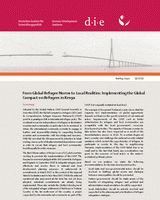From global refugee norms to local realities: implementing the global compact on refugees in Kenya
Dick, Eva / Markus RudolfBriefing Paper 19/2019
Bonn: German Development Institute / Deutsches Institut für Entwicklungspolitik (DIE)
DOI: https://doi.org/10.23661/bp19.2019
Dt. Ausg. u.d.T.:
Von globalen Flüchtlingsnormen zu lokalen „Realitäten“: die Umsetzung des Globalen Flüchtlingspaktes in Kenia
(Analysen und Stellungnahmen 15/2019)
Adopted by the United Nations (UN) General Assembly in December 2018, the Global Compact on Refugees (GCR) and its Comprehensive Refugee Response Framework (CRRF) point to a paradigm shift in international refugee policy. The social and economic independence of refugees in destination countries and communities in particular is to be increased. In return, the international community commits to engage in burden- and responsibility-sharing by supporting hosting countries and communities with knowledge and resources. With this new deal, the UN announced its intention to break existing vicious cycles of displacement and dependence on aid in order to ensure that refugees and host communities benefit equally from the measures.
The East African nation of Kenya is one of 15 pilot countries working to promote the implementation of the CRRF. The Kenyan Government pledged at the UN Summit for Refugees and Migrants in September 2016 to integrate refugees more effectively and involve them in national and local development planning processes. It underscored its commitments in March 2017 in the context of the regional Nairobi Declaration and Action Plan (NAP). While the national operational plan announced at the time has not yet been adopted, individual commitments are already being implemented. These also include the (further) development of the integrated refugee settlement of Kalobeyei in Turkana Country in the far north-west of the country, a project supported by the international community as part of the CRRF, but originally initiated at local level.
The example of Kenya and Turkana County shows that the (capacity for) implementation of global agreements depends not least on the specific interests of sub-national actors. Requirements of the CRRF, such as better infrastructure for refugees and host communities, are compatible with the local government’s economic development priorities. The capacity of Kenyan counties to take action has also been improved as a result of the decentralisation process in 2010. To a certain degree at least, counties can challenge the national security-related narratives which restrict the opportunities of refugees to participate in society to this day. In neighbouring Tanzania, implementation of the CRRF failed due in no small part to the fact that barely any consideration was given to the concerns of local actors in the nation’s centralised political system.
Based on our analysis, we make the following recommendations for German development policy:
Local state and non-governmental actors should be involved in drafting global norms and dialogue between municipalities should be promoted,
- Partner governments should be made aware of the benefits of integrating refugees and political and administrative implementation should be supported,
- Local stakeholders should be actively involved and supported in the planning and prioritisation of refugee integration strategies.


